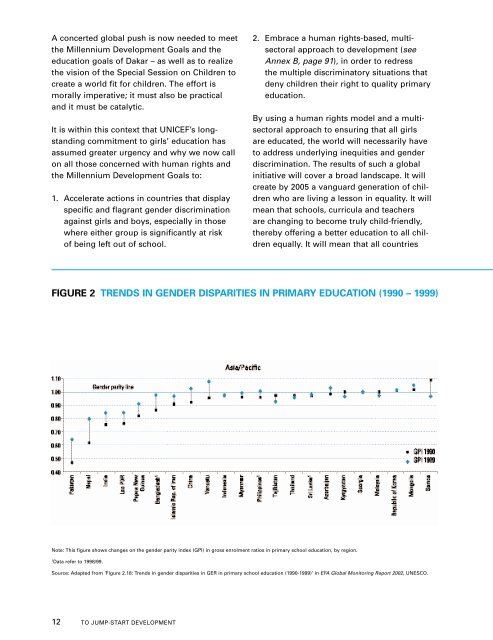THE STATE OF THE WORLD'S CHILDREN 2004 - Unicef
THE STATE OF THE WORLD'S CHILDREN 2004 - Unicef
THE STATE OF THE WORLD'S CHILDREN 2004 - Unicef
You also want an ePaper? Increase the reach of your titles
YUMPU automatically turns print PDFs into web optimized ePapers that Google loves.
A concerted global push is now needed to meet<br />
the Millennium Development Goals and the<br />
education goals of Dakar – as well as to realize<br />
the vision of the Special Session on Children to<br />
create a world fit for children. The effort is<br />
morally imperative; it must also be practical<br />
and it must be catalytic.<br />
It is within this context that UNICEF’s longstanding<br />
commitment to girls’ education has<br />
assumed greater urgency and why we now call<br />
on all those concerned with human rights and<br />
the Millennium Development Goals to:<br />
1. Accelerate actions in countries that display<br />
specific and flagrant gender discrimination<br />
against girls and boys, especially in those<br />
where either group is significantly at risk<br />
of being left out of school.<br />
2. Embrace a human rights-based, multisectoral<br />
approach to development (see<br />
Annex B, page 91), in order to redress<br />
the multiple discriminatory situations that<br />
deny children their right to quality primary<br />
education.<br />
By using a human rights model and a multisectoral<br />
approach to ensuring that all girls<br />
are educated, the world will necessarily have<br />
to address underlying inequities and gender<br />
discrimination. The results of such a global<br />
initiative will cover a broad landscape. It will<br />
create by 2005 a vanguard generation of children<br />
who are living a lesson in equality. It will<br />
mean that schools, curricula and teachers<br />
are changing to become truly child-friendly,<br />
thereby offering a better education to all children<br />
equally. It will mean that all countries<br />
FIGURE 2 TRENDS IN GENDER DISPARITIES IN PRIMARY EDUCATION (1990 – 1999)<br />
Note: This figure shows changes on the gender parity index (GPI) in gross enrolment ratios in primary school education, by region.<br />
1<br />
Data refer to 1998/99.<br />
Source: Adapted from ‘Figure 2.18: Trends in gender disparities in GER in primary school education (1990-1999)’ in EFA Global Monitoring Report 2002, UNESCO.<br />
12 TO JUMP-START DEVELOPMENT
















